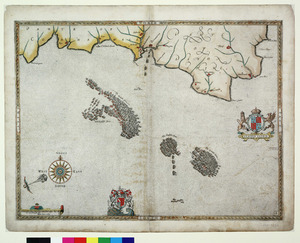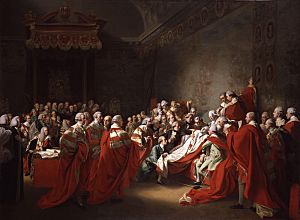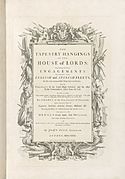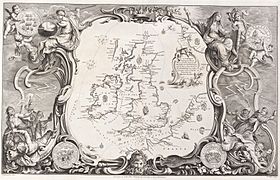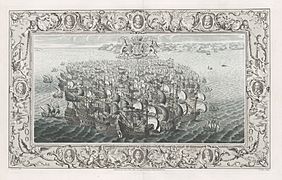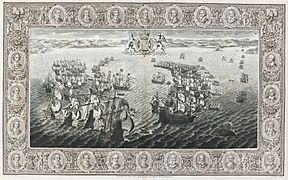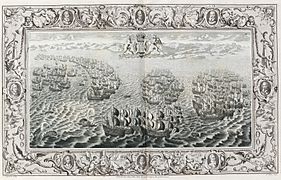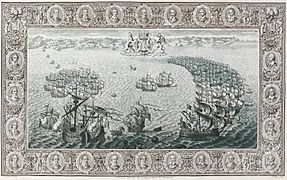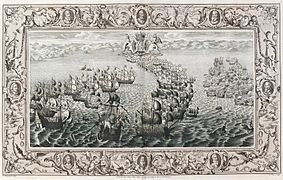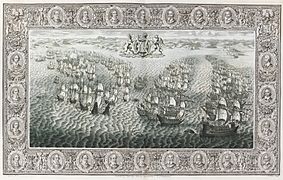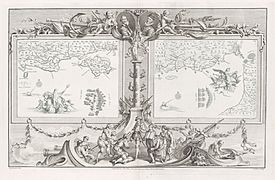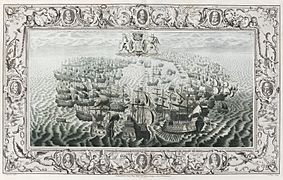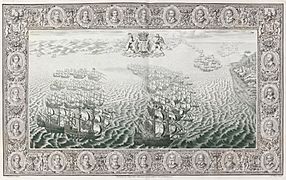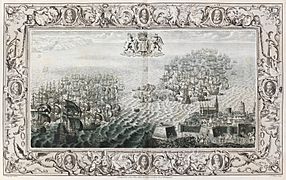Armada Tapestries facts for kids
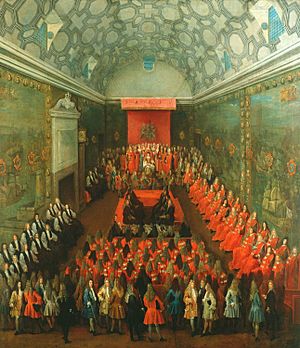
The Armada Tapestries were a set of ten large woven pictures. They were made to celebrate England's victory over the Spanish Armada. This was a huge Spanish fleet that tried to invade England in 1588.
The tapestries were ordered in 1591 by Lord Howard of Effingham. He was the leader of the Royal Navy during the battle. In 1651, these amazing tapestries were hung in the old House of Lords building. This was where important government meetings took place. Sadly, they were all destroyed in a big fire in 1834. This fire burned down the Houses of Parliament.
Contents
Creating the Armada Tapestries
After the battle in 1588, Lord Effingham asked Robert Adams to draw maps. These maps showed the fights between the English and Spanish ships. A Dutch painter named Hendrick Cornelisz Vroom used these maps. He created "bird's eye view" designs for the tapestries.
The tapestries were likely woven in Delft, a city in the Netherlands. They were made in the workshops of François Spierincx. He later made more tapestries for King James I in 1607.
By 1590, the Dutch often made special coins and medals. They used these to celebrate their wins against Spain. Lord Effingham probably saw how powerful these stories could be. He wanted the tapestries to show the English fleet as a strong, united force. This helped make Elizabeth I look like a great leader. The tapestries did not mention the Dutch helping in the battle.
Famous Faces in the Borders
The tapestries had special borders. These borders featured portraits of important people. They included naval commanders, captains, and other brave individuals. Some of these people were Francis Drake, Martin Frobisher, and John Hawkins. Lord Effingham himself was also pictured. Many other notable figures were included too.
Becoming Royal Property
In 1595, Lord Effingham paid £1,582 for the finished tapestries. They were very popular. In 1616, he sold them to King James I for a good profit. The King paid £1,628.
Before this, the tapestries were shown at Whitehall Palace. This was for the wedding of Princess Elizabeth in 1613. Later, King Charles I inherited the tapestries. He moved them to Oatlands Palace. He may have been embarrassed by his own failed trip to Spain in 1623.
During the Commonwealth Period
The ten tapestries were then stored at the Tower of London. In 1644, six of them were hung in the old Palace of Westminster. This was where the lords of Parliament met. After King Charles I was removed from power in 1649, Parliament made lists of his belongings. They planned to sell them. The tapestries were valued at £2,113.
However, the government decided to keep the "story of the eighty eight" tapestries. They were used by Oliver Cromwell at Whitehall Palace.
The tapestries were later returned to Westminster. A visitor from Germany saw them in 1710. He noted they were in poor condition. In the 1730s, a new doorway was made. A piece of one tapestry was cut out. This piece later went to the city of Plymouth. In 1760, eight of the tapestries were cleaned and fixed.
John Pine's Engravings

In 1739, a man named John Pine made engravings of the tapestries. He based his work on drawings by Clement Lemprière. Lemprière had used the original maps by Robert Adams.
You can even see the tapestries in a famous painting. It's called The Death of the Earl of Chatham by John Singleton Copley.
Engravings from John Pine's 1739 Publication


